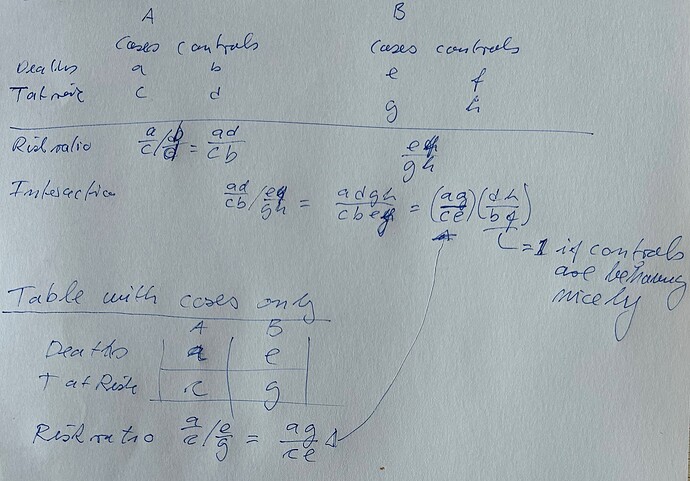Hi,
I have observational data with exposed cases and corresponding controls.
However, the cases can be sub-grouped into two groups A and B.
Group A and B now have their own controls.
Suppose I want to analyse time-to-death where
the question I want to answer is, if there is a difference between the survival times between group A and B in the exposed group.
Should I split the data into group A/controls and group B/controls and estimate the HR (given PH assumption is fulfilled and so on) for each dataset, or should I fit a single model:
~ exposure * subgroup
to see, if there is an interaction effect.
Any help appreciated:)
Best,
1 Like
Hi Laus
The controls are not needed – see the table with deaths and time at risk in the attached figure below. The interaction from the entire 2x8 table is the same as the main effect in the 2x2 table with the cases only (=ag/ce). The assumption is that the controls are behaving nicely – ie that (df/bf ~ 1). An argument for using the cases only is that the variance is smaller in the 2x2 table than in the 2x8 table. You can check it out in a simulation. (it is not important whether you look at RR, IRR or OR).
An argument against PH: let’s say that individuals are randomized to treatment A or B. Assume that A is working – ie meaning that the mortality is smaller in A than in B. After some time more of the frail individuals in B will have died than in A. This means that more frail individuals are alive in A – ie individuals who have higher mortality than the non-frail. This is why it is often seen that a treatment effect is wearing‐off with time. This is that the same as saying that the hazards are not proportional. In brief, saying that the treatment is working is the same as saying that the hazards are not proportional. See more here: Martinussen. Subtleties in the interpretation of hazard contrasts. Lifetime Data Analysis 2020.
Lastly, it is always a good idea to think about zero – ie time zero in the follow-up. With mortality, age or time-since initiation of treatment are usually the important time scale
Cheers
Esben
1 Like
Hi Esben,
Thank you for the thorough answer and for reminding me of the article
you reference - the HR does indeed have it’s subtleties!
Br,
Laus
